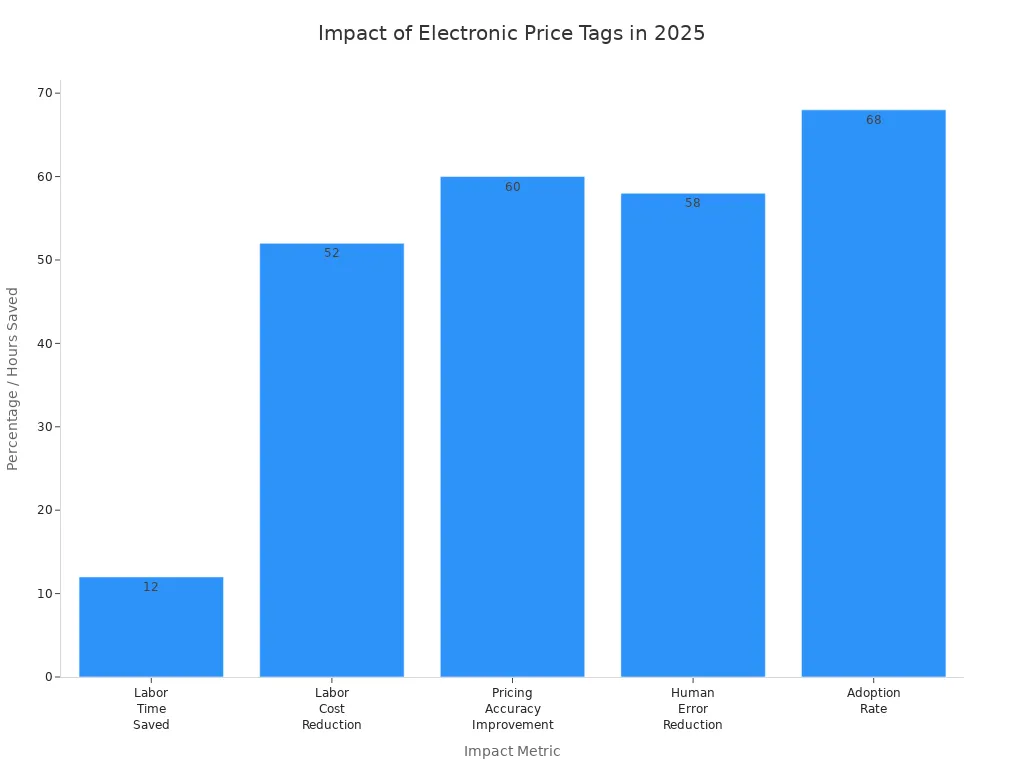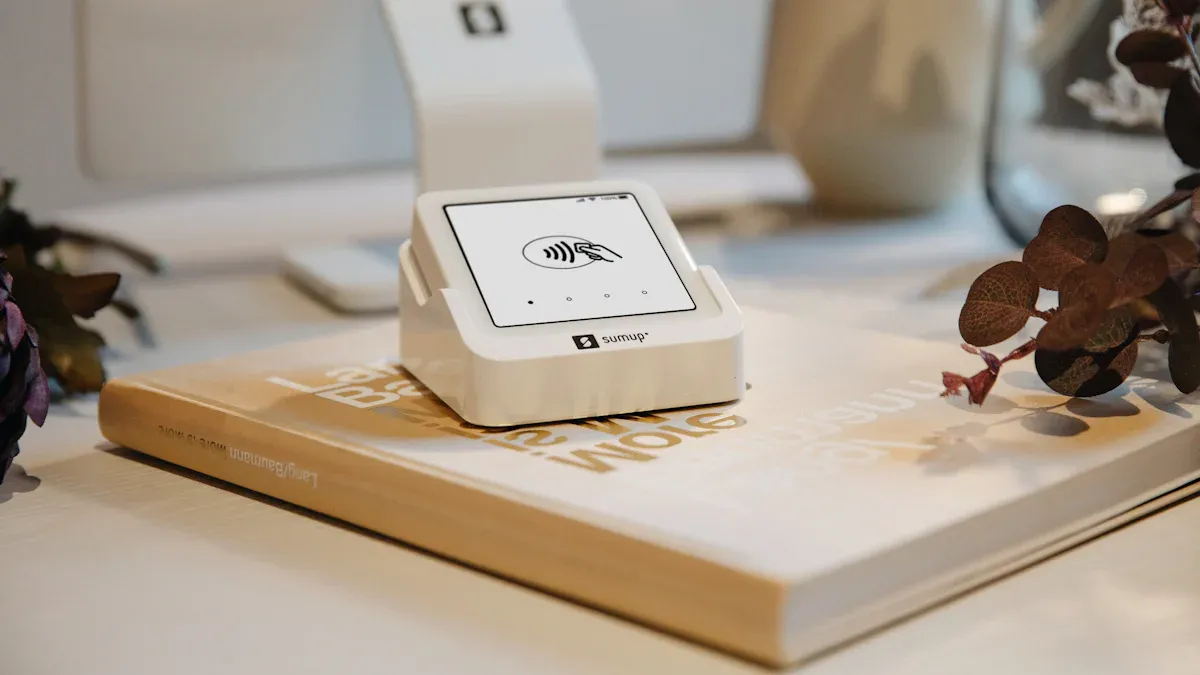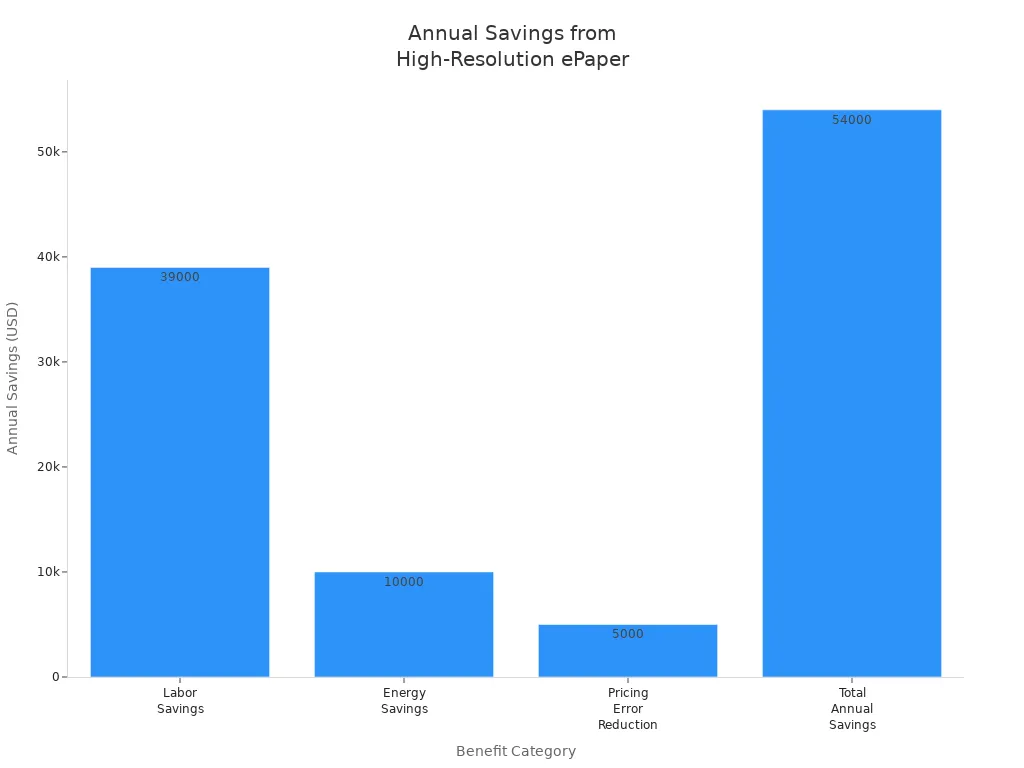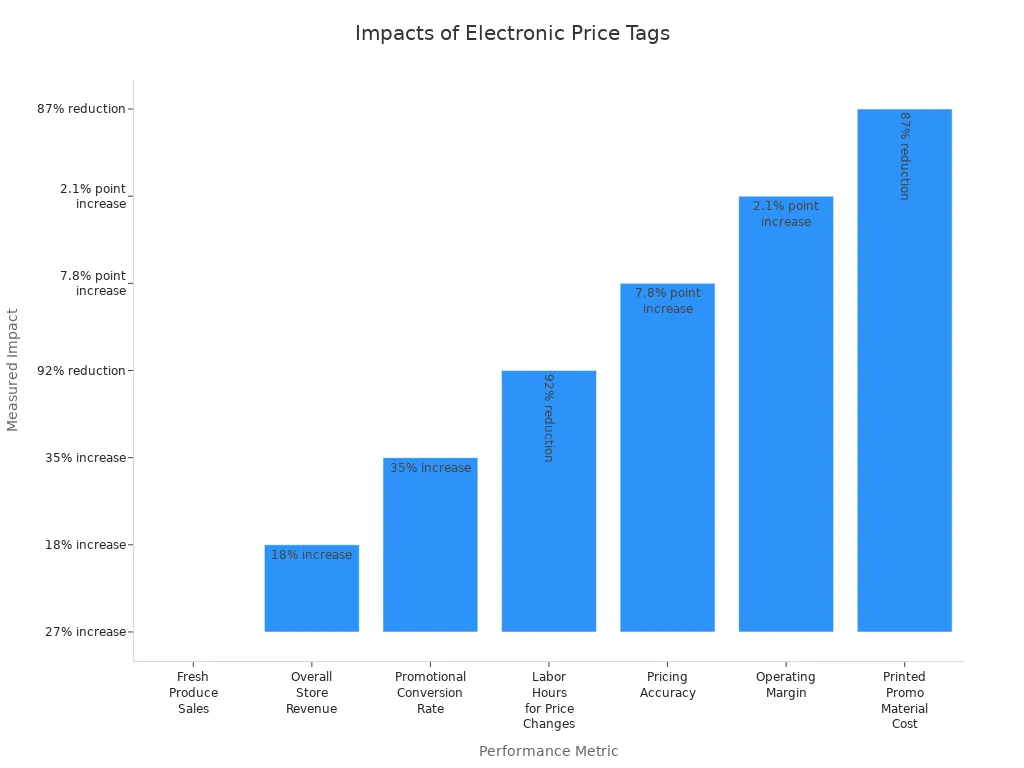
Electronic price tag solutions in 2025 are transforming the retail landscape with advanced Esl Retail technology. Electronic Shelf Labels now feature visually rich displays, including images and icons, making product information instantly clear. By leveraging the ESL Gateway AP for automated updates, retailers can save up to 12 hours per week and cut labor costs by more than 50%. Implementing ESL Price Tag systems leads to a 60% improvement in pricing accuracy and significantly reduces errors. The chart below illustrates these measurable benefits in retail operations.

| Metric / Impact Category | Statistical Evidence / Description |
|---|---|
| Labor Time Saved | Up to 12 hours saved per week per store by automating price updates through ESL Gateway AP, allowing staff to focus more on customer service. |
| Labor Cost Reduction | Approximately 52% reduction in labor costs related to price updates due to automation with Electronic Shelf Labels. |
| Pricing Accuracy Improvement | 60% increase in pricing accuracy after adopting electronic price tags, reducing pricing discrepancies. |
| Human Error Reduction | 58% reduction in human error in pricing and inventory marking through ESL Price Tag automation. |
| Adoption Rate | Over 68% of large retail chains have implemented Electronic Shelf Labels recognizing these efficiency benefits. |
| Customer Engagement Enhancements | Real-time price updates, dynamic pricing, interactive features (e.g., QR codes), and consistent shelf-to-checkout pricing improve customer trust and shopping experience. |
| Operational Efficiency Gains | Faster price changes (seconds vs. hours/days), centralized control via ESL Gateway AP, and reduced manual relabeling improve store operations. |
| ROI Influencing Metrics | Improvements in sales per square foot, reduced refund/return rates, increased repeat customer rate, and better conversion rates contribute to enhanced ROI. |
Electronic Price Tag Display Capabilities in 2025

Visualizing More Than Prices
Product Images and Specifications
You now experience a retail environment where electronic price tags do much more than show numbers. These advanced tags use high-resolution displays to present product images, technical specifications, and even nutritional details. With digital shelf labels, you can view a product’s origin, dietary information, or care instructions right at the shelf. This level of detail helps you make informed decisions quickly and confidently.
Modern display technology offers a clear advantage. LCD screens deliver vibrant colors and fast updates, while full-graphic E-paper displays provide paper-like readability and extended battery life. You benefit from both visual appeal and energy efficiency. Retailers can update thousands of tags in minutes, ensuring that every product detail remains current and accurate.
Icons for Quick Recognition
Icons have become essential for fast, intuitive shopping. Electronic price tags in 2025 use icons to highlight key product attributes—such as organic, gluten-free, or vegan—directly on the display. You spot allergen warnings, eco-labels, and certifications at a glance. This visual shorthand speeds up your shopping and reduces confusion, especially in busy aisles.
Tip: Look for icons on digital shelf labels to quickly identify products that match your preferences or dietary needs.
Supporting Barcodes, QR Codes, and Graphics
Scannable Codes for Inventory and Checkout
You interact with a new generation of electronic price tags that support a wide range of barcode formats, including UPC, EAN, Code 128, and QR codes. These codes appear clearly on the display, ready for scanning at checkout or during inventory checks. Retailers use real-time barcode generation and preview features to ensure accuracy and efficiency. You benefit from faster, more reliable transactions and improved product traceability.
The display capabilities extend to dynamic QR codes, which connect you to digital content such as product manuals, traceability data, or even augmented reality experiences. NFC integration is also emerging, allowing you to tap your smartphone for instant access to promotions or product information.
Promotional Graphics and Offers
Retailers now use digital shelf labels to showcase promotional graphics, time-limited offers, and branded visuals. The display can switch between standard pricing and eye-catching promotions within seconds. You see animated graphics or highlighted discounts that draw your attention to special deals. This dynamic approach increases engagement and helps you discover new products or savings opportunities.
| Barcode Type | Typical Use Case | Display Feature |
|---|---|---|
| UPC/EAN | Checkout, inventory | Small, scannable codes |
| QR Code | Promotions, info access | Dynamic, interactive |
| Data Matrix | Traceability, compliance | Dense data, compact |
Customization and Branding
Store Logos and Brand Colors
You notice that electronic price tags now reflect each retailer’s unique identity. The display supports store logos, brand colors, and custom templates. Retailers use these features to reinforce their branding and create a cohesive in-store experience. You recognize familiar logos and color schemes, which builds trust and helps you navigate the store more easily.
Digital shelf labels also enable personalized advertisements and coupons. Retailers can tailor content to specific aisles or customer segments, making your shopping experience more relevant and engaging.
Regulatory and Allergen Icons
Compliance and transparency have become priorities. Electronic price tags display regulatory icons, recycling symbols, and allergen warnings as required by law. You see clear indicators for gluten-free, nut-free, or organic products, ensuring you shop safely and confidently. These display capabilities help retailers meet regulatory standards and demonstrate their commitment to customer well-being.
Note: The integration of regulatory and allergen icons on digital shelf labels supports both compliance and customer trust.
Epaper Price Tags: Technology and Benefits
High-Resolution ePaper and eInk Displays
Superior Readability and Contrast
You experience a new standard of clarity with epaper price tags in 2025. These digital displays use electrophoretic technology, which moves charged particles inside microcapsules to create sharp images and text. This approach delivers high contrast and glare-free readability, even under bright store lighting or direct sunlight. You can easily read prices, product details, and promotional graphics from any angle, thanks to the wide viewing range and anti-glare surfaces.
Retailers now rely on electronic paper price tags that use second-generation System-on-Panel (SoP) technology. This innovation, developed through partnerships between E Ink and Realtek, results in slimmer borders and more compact displays. You benefit from a sleek, modern look on every shelf, while stores enjoy improved efficiency and integration.
| Benefit Category | Description |
|---|---|
| Ultra-low Power Consumption | E-paper’s bi-stable nature allows content retention without power, leading to longer battery life and reduced maintenance. |
| High Contrast & Readability | Sharp, high-contrast text and graphics remain clear even in bright lighting, with anti-glare surfaces enhancing visibility. |
| Reflective Display Nature | Uses ambient light to maintain visibility without glare or fading, ensuring readability in direct sunlight. |
| Real-time Updates | Supports dynamic pricing and promotional content updates, reducing human error and improving operational efficiency. |
| Detailed Graphics Support | Enables display of multi-line text, barcodes, QR codes, and promotional graphics with high resolution. |
| Sustainability | Reduces paper waste and electronic waste due to long battery life and fewer replacements. |
| Labor Cost Savings | Automates price updates, saving significant manual labor hours and reducing errors. |
| Scalability | Wireless connectivity allows centralized control and rapid updates across multiple retail locations. |
| Customer Satisfaction | Clear, consistent pricing improves shopper trust and encourages purchases. |
| Operational Efficiency | Streamlines workflows, inventory management, and promotional speed, enhancing overall store performance. |
Energy Efficiency and Longevity
You notice that epaper price tags last for years on a single battery. The bi-stable nature of ePaper means the display holds its image without using power, only drawing energy during updates. This ultra-low power consumption leads to fewer battery replacements and less electronic waste. Retailers see significant cost savings and sustainability improvements.

You also benefit from the reliability of these digital solutions. Stores can update thousands of tags wirelessly, ensuring accurate pricing and promotions at all times. The result is a seamless shopping experience and improved operational efficiency.
Full-Screen Picture and Icon Support
Wireless Transmission of Visual Data
You see vibrant, full-screen images and icons on digital price tags, thanks to advancements in digital display technology. Modern systems support wireless transmission of high-resolution pictures, graphics, and promotional content. Retailers can instantly update visuals across all shelves, keeping information fresh and engaging.
Hanshow and Vusion have introduced solutions that allow you to view static or dynamic images in a wide range of colors, including black, white, red, yellow, green, and blue. This capability enhances product visibility and draws your attention to special offers or important product features.
Remote Customization Capabilities
You benefit from remote customization features that let retailers tailor content for different products, aisles, or even individual stores. With centralized control, stores can adjust layouts, branding, and promotional graphics in real time. This flexibility ensures that every electronic price tag matches the store’s identity and marketing goals.
- Wireless updates reduce manual labor and errors.
- Centralized platforms enable precise control over pricing, inventory, and promotions.
- Dynamic content helps you find relevant information quickly and easily.
Tip: Look for digital price tags with full-color displays and clear icons to enjoy a more interactive and informative shopping experience.
Bluetooth Electronic Shelf Label Systems
Bluetooth electronic shelf label systems in 2025 set a new benchmark for retail efficiency and reliability. You experience seamless, real-time updates and robust connectivity, all while stores benefit from ultra-low power operation and minimal maintenance.
Real-Time Wireless Communication
Instant Price and Content Updates
You see price changes and promotional content appear on shelves within seconds. Wireless communication transmits approved updates from a central system to every label, ensuring you always view accurate pricing. This process eliminates manual relabeling and synchronizes with online pricing, so you never face confusion at checkout. Two-way communication allows each label to send feedback about battery status or malfunctions, which helps staff address issues before they affect your shopping experience.
Note: Real-time updates mean you always see the latest deals and accurate prices, even during flash sales or inventory changes.
Secure and Scalable Connectivity
You shop in stores where thousands of electronic shelf labels operate smoothly, thanks to secure and scalable Bluetooth connectivity. Standardization ensures interoperability, so retailers can source labels from multiple vendors without compatibility issues. Over-the-air firmware updates keep every label current and secure. Bluetooth 5.4 features, such as PAwR and EAD, support reliable, bidirectional communication across large retail spaces. Integration with Wi-Fi and cloud AI models enables efficient stock monitoring and replenishment, making your shopping experience smoother.
- Standardized protocols ensure easy installation and long-term maintenance.
- End-to-end encryption and authentication protect pricing data and prevent tampering.
| Feature / Benefit | Description |
|---|---|
| Wireless Standard | Based on Bluetooth Core 5.4, enabling multi-vendor interoperability and ultra-low power consumption. |
| Interoperability | Standardized ESL profile allows sourcing from multiple vendors with assured compatibility. |
| Operational Efficiency | 80% reduction in time spent on pricing updates; 2-5% increase in sales after ESL implementation. |
| Retail Benefits | Supports dynamic pricing automation, real-time promotions, improved inventory management, and shopper satisfaction. |
Low Power Consumption and Battery Life
Ultra-Low Power Operation
You notice that digital price tags rarely need battery changes. Bluetooth electronic shelf label systems use e-paper displays and advanced wireless chips to minimize power draw. E-paper technology only consumes energy during updates, so the display remains visible without draining the battery. Coin cell batteries, such as CR2032 or CR2450, provide stable power for years.
Maintenance and Replacement Cycles
You benefit from reliable digital shelf labels that last three to ten years, depending on update frequency and display complexity. In typical retail scenarios with two to four updates per day, battery life ranges from three to six years. Advanced platforms, like SOLUM Newton, extend this even further with hardware and software optimizations. Low self-discharge rates and robust battery chemistry ensure consistent performance and reduce electronic waste.
| Product Model | Average Battery Life | Battery Type | Usage Scenario / Notes |
|---|---|---|---|
| Typical Bluetooth ESLs | 3 to 10 years | Coin cell (CR2032, CR2450, CR2477) | Battery life depends on update frequency and display tech; e-paper extends life |
| Retail scenario (2-4 updates/day) | 3 to 6 years | CR2450 or similar | Moderate update frequency typical in retail environments |
| High-frequency updates | Around 3 years | Coin cell | Frequent updates (multiple per hour) reduce battery life due to higher power use |
| SOLUM Newton platform | Up to 10 years | Not specified | Advanced hardware/software optimizations enable long life even with heavy feature use |
Tip: Long battery life and low maintenance mean you enjoy uninterrupted, accurate pricing and promotions every time you shop.
Dynamic Pricing and Real-Time Updates

Centralized Price Management
You gain full control over your store’s pricing strategy with centralized price management. Modern systems use cloud-based platforms or centralized server software to manage every electronic price tag across all locations. You can synchronize price and content updates in real time, ensuring consistency on every shelf. These platforms integrate with your existing ERP, POS, and inventory systems, so you never need to worry about manual data entry or mismatched prices.
- Centralized dashboards let you design, schedule, and monitor label changes from one interface.
- You can deploy price updates to thousands of tags with a single click, reducing IT complexity.
- Multi-level user access and encrypted data transfer keep your operations secure.
Automated Price Adjustments
You benefit from automated price adjustments powered by AI. The system analyzes sales data, competitor prices, and inventory levels to recommend optimal pricing. You can set profit guardrails and business goals, allowing the platform to balance sales, competitiveness, and profitability. This automation ensures your pricing remains agile and responsive to market changes.
- AI-driven dynamic pricing helps you optimize margins by adjusting prices in real time.
- The system maintains omnichannel price consistency, so online and in-store prices always match.
- You can roll out dynamic pricing quickly, reducing time and cost compared to manual updates.
- The platform enables you to monitor competitor pricing and test new strategies with minimal risk.
- You can respond to supply chain disruptions by adjusting prices to manage inventory and absorb cost increases.
Flash Sales and Time-Limited Offers
You can launch flash sales or time-limited offers instantly. Centralized control allows you to schedule promotions and update every electronic price tag in seconds. You attract more shoppers with real-time discounts and targeted campaigns. The system supports digital promotions, QR code integration, and loyalty campaigns, making your pricing strategy more dynamic and engaging.
Tip: Use time-limited offers to clear excess inventory or boost sales during slow periods. Real-time updates ensure every customer sees the correct price.
Error Reduction and Labor Savings
You eliminate manual errors and save valuable staff time with automated label changes. The electronic price tag system updates prices directly from your backend, so you never need to print or replace paper labels again.
Automated Label Changes
Automated updates ensure every price on the shelf matches your POS system. You reduce pricing errors from 3% to just 0.01%. Staff no longer spend hours changing labels, freeing them to focus on customer service and other high-value tasks.
| Efficiency Aspect | Description | Quantitative Impact |
|---|---|---|
| Labor Time Reduction | Automated, real-time price updates eliminate manual price tag changes | Significant reduction in staff hours spent |
| Pricing Error Elimination | Digital updates ensure correct prices, reducing human errors | Pricing errors reduced from 3% to 0.01% |
| Operational Cost Savings | No need for printing or replacing paper labels | Saves on printing and labor expenses |
| Pricing Efficiency Increase | Instant shelf label changes via backend system | Pricing efficiency increased by 50 times |
Streamlined Store Operations
You streamline store operations by integrating electronic price tag automation with your retail systems. Price updates now take seconds instead of hours or days. Real-time synchronization with your POS nearly eliminates manual errors. You see a 60% improvement in pricing accuracy and up to 50 labor hours saved each week. Staff can focus on customer engagement, while your store maintains a competitive edge with accurate, up-to-date pricing.
Integration with Retail Systems and Smart Store Solutions
AI-Powered Shelf Monitoring
Stock Level Detection
You benefit from digital price tag solutions that connect wirelessly to your store’s central database. These solutions enable real-time stock level detection, so you always know which products need replenishment. AI-powered systems analyze sales and inventory data, alerting staff when shelves run low. This automation reduces manual checks and ensures products remain available for your customers.
- Wireless connectivity keeps shelf data current.
- AI tracks inventory movement and predicts restocking needs.
- Staff receive instant notifications for low-stock items.
Planogram Compliance
Maintaining planogram compliance becomes effortless with integrated retail solutions. AI monitors shelf layouts and compares them to your store’s planogram. When products are misplaced or missing, the system flags discrepancies. You can quickly correct issues, ensuring shelves look organized and meet brand standards. This approach improves the shopping experience and supports merchandising goals.
Tip: Automated planogram checks help you maintain consistency across all store locations.
Customer Engagement Tools
Interactive Product Information
You engage shoppers with digital price tags that display more than just prices. These solutions present nutritional facts, product origins, and even QR codes for instant access to detailed information. Customers scan codes to view reviews, video tutorials, or 3D demos, making their shopping journey interactive and informative. This digital approach transforms the shelf into a smart retail solution.
Personalized Offers via Mobile Integration
Personalization drives loyalty in modern retail. Digital price tag solutions integrate with loyalty programs and mobile apps, delivering tailored offers directly to your customers. When shoppers scan a QR code, they receive discounts or recommendations based on their preferences. Augmented reality features allow virtual try-ons or product previews, creating memorable experiences that encourage repeat visits.
- Personalized content increases engagement and conversion rates.
- Real-time updates keep promotions fresh and relevant.
Seamless POS and Inventory Sync
Real-Time Inventory Updates
You achieve real-time synchronization between your POS, inventory, and digital price tag solutions. Middleware bridges communication between systems, ensuring pricing and stock data remain consistent. Wireless networks transmit updates instantly, so shelf prices always match checkout prices. This integration eliminates pricing errors and supports dynamic pricing strategies.
Unified Data Management
Integrated retail solutions provide centralized control over product information, pricing, and promotions. Data management systems synchronize updates across all platforms, reducing manual labor by up to 95%. You gain full visibility into inventory status, enabling better decision-making and efficient store operations. Advanced features, such as pick-path optimization and restocking prioritization, further enhance productivity.
| Benefit | Description |
|---|---|
| Pricing Accuracy | Shelf and POS prices always match |
| Labor Savings | Fewer manual updates, more time for customers |
| Inventory Visibility | Real-time stock status supports better planning |
| Customer Experience | Consistent, accurate information builds trust |
Note: Seamless integration with digital price tag solutions supports omnichannel pricing and unified store management.
Real-World Adoption of Electronic Price Tags
Leading Retailers and Industry Examples
Grocery Chains and Supermarkets
You see grocery chains leading the way in digital transformation. Major supermarkets have adopted electronic price tags to streamline operations and improve accuracy. At FreshMarket, you notice a 27% increase in fresh produce sales after implementing these solutions. The store also reports an 18% rise in overall revenue and a 35% boost in promotional conversion rates. Labor hours for price changes drop by 92%, freeing staff to focus on customer service. Pricing accuracy improves from 92% to 99.8%, which nearly eliminates pricing disputes at checkout.
| Performance Metric | Measurable Impact at FreshMarket |
|---|---|
| Fresh Produce Sales Increase | 27% increase |
| Overall Store Revenue Growth | 18% increase |
| Promotional Conversion Rate | 35% increase |
| Labor Hours for Price Changes | 92% reduction |
| Pricing Accuracy Improvement | From 92% to 99.8% accuracy |
| Operating Margin Improvement | 2.1 percentage point increase |
| Printed Promotional Material Cost | Reduced by 87% |
Note: Supermarkets benefit from real-time updates and dynamic pricing, which help maintain competitiveness in the fast-paced retail industry.
Electronics and Specialty Stores
You find electronics retailers and specialty stores embracing electronic price tags to manage complex inventories and frequent price changes. Sam’s Club, for example, achieves over 90% pricing accuracy and reduces checkout times by 23%. The store experiences up to a 20% increase in revenue through AI-driven price optimization. Profit margins improve by up to 5%, and member engagement rises by 50% as more shoppers use scan-and-go features. These results highlight the value of electronic shelf labels in high-value, high-turnover environments.
| Performance Metric | Measurable Impact at Sam’s Club |
|---|---|
| Pricing Accuracy | Over 90% accuracy, reducing pricing errors |
| Revenue Increase | Up to 20% increase via AI-driven price optimization |
| Profit Margin Improvement | Up to 5% margin improvement |
| Checkout Time Reduction | 23% faster checkout process |
| Labor Cost Savings | Significant savings due to automation |
| Member Engagement | 50% increase in scan-and-go adoption over three years |
| Revenue Growth Rate | Enhanced through dynamic pricing and promotions |
| Sell-Through Rate | Increased via efficient inventory management |
| Customer Retention Rate | Strengthened by consistent, transparent pricing |
| Stockout Rate | Reduced due to real-time inventory and pricing updates |
Measurable Impact on Store Performance
Increased Sales and Conversion Rates
You observe that electronic price tags drive measurable improvements in sales and conversion rates. Retailers report up to a 20% increase in revenue and a 35% rise in promotional conversion rates. Dynamic pricing and real-time updates help you capture more sales opportunities and respond quickly to market trends. Efficient inventory management boosts sell-through rates and reduces stockouts, ensuring products remain available when customers want them.

Improved Customer Satisfaction
You experience greater satisfaction as pricing accuracy climbs above 90% in many retail environments. Faster checkout times, transparent pricing, and fewer errors build trust and encourage repeat visits. Retailers see stronger customer retention rates and higher engagement, especially when digital shelf labels support scan-and-go or mobile integration features. The retail industry recognizes these benefits as essential for staying competitive and meeting evolving shopper expectations.
Overcoming Challenges and Ensuring ROI
Addressing Upfront Costs and Investment
Total Cost of Ownership Analysis
You face several cost factors when you consider electronic price tag solutions. The initial investment covers hardware, software, and infrastructure setup. Each unit ranges from $5 to $15, depending on display size and technology. You also need to budget for software integration and possible IT upgrades. Maintenance costs include battery replacements every three to five years, though some models offer solar charging to reduce expenses. Hidden costs may arise from employee training, connectivity issues, and software licensing fees.
- You should assess your store size, product range, and required features to avoid overspending.
- Choosing vendors with transparent pricing helps you prevent hidden fees.
- Ongoing costs, such as maintenance and licensing, factor into your total cost of ownership.
- You maximize returns by using data analytics from these solutions to inform pricing and operations.
Note: Many retailers find the investment worthwhile due to long-term efficiency, reduced labor costs, and improved customer experience.
Financing and Leasing Options
You can explore financing or leasing options to manage upfront costs. Many vendors offer flexible payment plans, allowing you to spread expenses over time. This approach helps you adopt advanced solutions without straining your budget. By balancing initial costs with projected labor savings and increased sales, you ensure a positive return on investment.
Training, Support, and Change Management
Staff Onboarding
You need effective training to ensure successful adoption of electronic price tag solutions. Start with role-based training tailored to each user’s responsibilities. Use hands-on exercises, such as simulations and role-playing, to build confidence. Involve your sales team early so they can explain and support new pricing strategies.
Ongoing Support and Maintenance
You benefit from ongoing support and refresher courses after implementation. Provide detailed user manuals and troubleshooting guides. Establish a help desk or online chat for timely assistance. Update training materials regularly to reflect new features and system updates.
| Training Aspect | Key Points |
|---|---|
| Initial Training Investment | Critical for adoption and long-term success. |
| Role-Based Training | Tailored to user roles, affecting cost and scheduling. |
| Training Delivery Methods | Options include virtual, on-site, self-paced, and blended learning. |
| Budgeting and ROI | View training as an investment; refine continuously for best results. |
| Phased and Blended Approach | Combining methods supports diverse user needs and optimizes outcomes. |
Tip: Continuous support and updated resources help your team adapt to evolving solutions and maximize their benefits.
Security and Data Privacy
Protecting Store and Customer Data
You must protect both store and customer data when you deploy electronic price tag solutions. These systems often connect to centralized databases and may collect consumer behavior data. You need robust security measures to prevent hacking, data breaches, and pricing errors. Technical reliability ensures you avoid legal issues and maintain customer trust.
Compliance with Regulations
You must comply with consumer protection and privacy laws. Real-time price updates and dynamic pricing require transparency to avoid misleading customers. If your solutions collect biometric or personal data, you must obtain proper consent and inform customers about data usage. Regular audits and clear internal policies help you stay compliant with evolving regulations.
Note: Ensuring transparency and technical reliability protects your business from regulatory risks and builds consumer confidence in your solutions.
Electronic price tags in 2025 set a new benchmark for retail. You see advanced displays with pictures and icons that make shopping easier and more engaging. Retailers and shoppers both gain from these innovations. The table below highlights key benefits:
| Benefit | Impact |
|---|---|
| Labor Savings | Up to 80% less time on price updates |
| Operational Cost Cuts | Annual savings up to $54,000 |
| Pricing Accuracy | Fewer errors, stronger customer trust |
| Inventory Management | Over 90% stock update accuracy |
| Customer Experience | Transparent, reliable pricing |
| Dynamic Promotions | Real-time, targeted offers |
You benefit from accurate prices and dynamic promotions. Retailers enjoy lower costs and better efficiency. As technology evolves, electronic price tags will continue to shape the future of retail, offering even greater value and flexibility.
FAQ
What is the lifespan of a modern electronic price tag?
You can expect most electronic price tags to last three to ten years. Battery life depends on update frequency, display type, and store environment. E-paper displays usually offer the longest lifespan.
Can you update all price tags at once?
Yes. You can update thousands of electronic price tags simultaneously using centralized software. Wireless technology ensures every tag receives accurate pricing and promotional information in seconds.
Are electronic price tags secure against tampering?
You benefit from advanced encryption and authentication protocols. These features protect pricing data and prevent unauthorized changes. Regular firmware updates further enhance system security.
Do electronic price tags support multiple languages?
You can display product information in several languages. Most systems allow you to switch languages or customize content for different regions, improving accessibility for diverse shoppers.
How do electronic price tags handle promotions and flash sales?
You can schedule and launch promotions instantly. The system updates all relevant tags in real time, ensuring every customer sees the correct offer during a flash sale or special event.
What happens if a tag loses connection or power?
If a tag loses connection, it retains the last displayed information. E-paper tags hold content without power. You receive alerts for any offline or low-battery tags, so you can address issues quickly.
Can you integrate electronic price tags with existing POS and inventory systems?
Yes. Most solutions offer seamless integration with your POS and inventory platforms. This ensures real-time synchronization of prices, stock levels, and promotions across all channels.
Tip: Always consult your vendor for specific integration capabilities and compatibility with your current systems.


